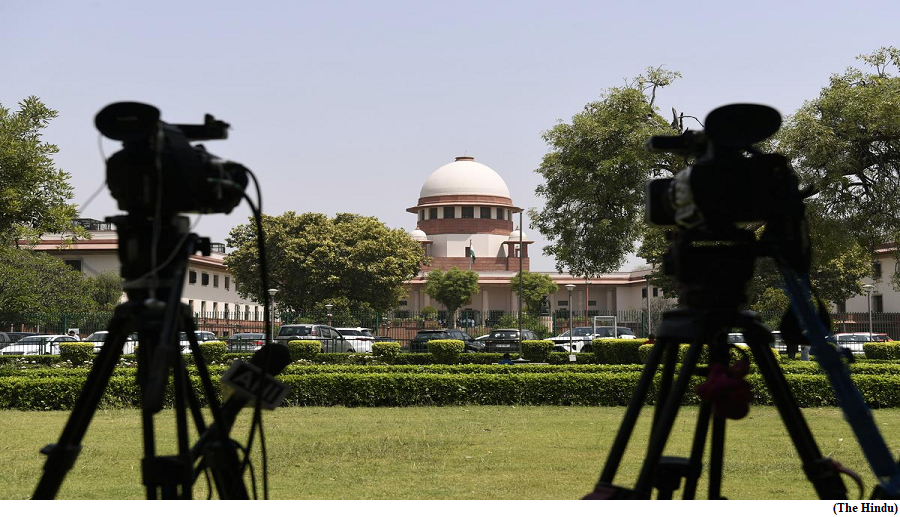A judgment that upholds the Constitution (GS Paper 2, Judiciary)

Context:
- The Supreme Court judgment in the Media One case (Madhyamam Broadcasting Ltd Media One Headquarters v. Union of India and Others) requires a political reading and not merely a legal one.
- It is a landmark judgment on the freedom of expression and a judicial fiat against sealed cover malpractice.
Details:
- It endorses the citizen’s right to question the state by distinguishing the government from the nation. It is a judicial admonition against the misuse of the rhetoric of national security to cover up the state’s arbitrariness.
- The judgment comes at a time when the Centre is being criticised for its attempts to destabilise the institutions of democracy.
- The Supreme Court too faces its share of criticism. It has postponed hearings on important cases such as electoral bonds and the dilution of Article 370.
Related cases:
- In Anoop Baranwal v. Union of India, it took away the power of appointment of Election Commissioners from the sole domain of the executive and directed the constitution of a committee comprising the Chief Justice of India, the Prime Minister, and the Leader of the Opposition to select them. The contribution of the Chief Justice of India, D.Y. Chandrachud, in modernising the court is remarkable.
- The Media One judgment has underlined the institutional capacity of the court in troubled political times. In the past, many constitutional principles were developed by the court when the matter was either infructuous or had mere academic value.
- When the Bommai case was decided in 1994, holding that federalism and secularism are the basic features of the Constitution, the real dispute in the case, the correctness of the dissolution of a few State governments did not even survive for consideration, as elections were held in those States subsequently.
- Again, when the Puttaswamy case challenging the Aadhaar project was decided in 2017, the Supreme Court only expounded the idea of privacy and related concepts at a doctrinal level, without a direct and immediate encounter with the executive, which, by that time, had completed the project.
Media One case:
- In the Media One case, the court directly confronted the Centre, which unilaterally cancelled the licence issued to the television channel citing “national security,” and directed it to renew the licence.
- It considered all the major doctrinal issues such as the right to fair hearing, proportionality standard and public interest claims and issued directives to the Centre in concrete terms.
- The Supreme Court, set aside the orders passed by the Ministry of Information & Broadcasting (MIB) on January 31, 2022, and the Kerala High Court on March 2, 2022, refusing to renew Malayalam news channel Media One’s broadcast license.
- In its 134-page judgment, the Supreme Court upheld Media One’s appeal on two procedural grounds, namely, principles of natural justice and proportionality.
Global instances:
- In the global context, populist autocracies try to crush the judiciary with their majoritarian impulse.
- In Israel, the present mass movement is predominantly against Prime Minister Benjamin Netanyahu’s move to meddle with the independence of the judiciary.
- In Bolivia, judges have been arbitrarily dismissed in the last few years. In Poland, by lowering the retirement age of judges, the regime sent out older judges and inducted new persons who are loyalists of the government.
The court and the Opposition:
- The Media One judgment shows the judiciary’s effort to resist majoritarian overtones. The court has taken a counter majoritarian role, which is qualitatively different from the role that the Opposition is supposed to play.
- The task before the court, however, is not to uphold the Opposition’s politics, even when it might be legitimate. Recently, for instance, the apex court rightly dismissed a plea by Opposition parties, which alleged arbitrary use of central probe agencies against them. The grievance is genuine, but it needs a political solution, not an adjudicatory resolution.
- This is how the court’s constitutional politics vary from the Opposition’s politics.
- The court can only put forth a judicial or constitutional check against an aggrandising State. It cannot pose a political check, which can only happen by way of mass movements or electoral decisions. Yet, in the former, there is ‘politics’ involved and its impact could be political.
Way Forward:
- It is this constitutional politics that enhances the intrinsic value of the Media One verdict.
- Yet, for the survival of the Constitution, people might need a struggle outside the court, which should complement the court’s counter majoritarian postures.


